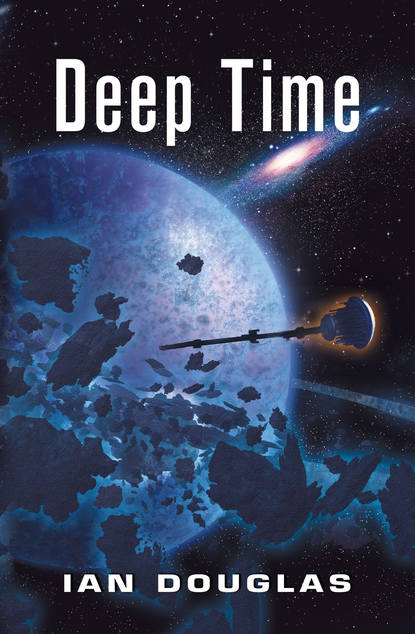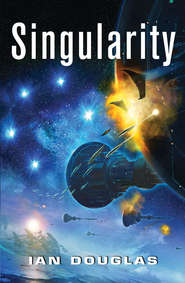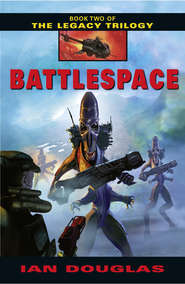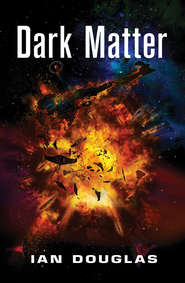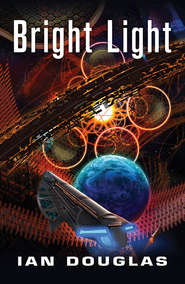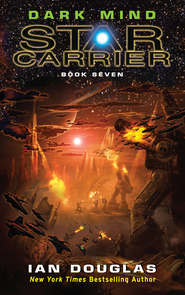По всем вопросам обращайтесь на: info@litportal.ru
(©) 2003-2024.
✖
Deep Time
Настройки чтения
Размер шрифта
Высота строк
Поля
“Do it. The Marines are wrapping things up at Verdun. And Charlie out there has just become our number-one priority.”
But one squadron against a frigate-sized ship of unknown capabilities and escorting fighters—those were not good odds. He flashed an order to the two capital ships now maneuvering down to low Earth orbit, ordering them to join the chase as well, but they almost certainly wouldn’t be able to catch up with Charlie One.
Quickly, Gray searched the fleet network, looking for a warship positioned in such a way that it could intercept the fleeing alien. Let’s see … Mars and Jupiter were both at completely wrong angles, with Earth between them and the alien ship just now. There was a small USNA flotilla still out in Saturn space, watching over the newly recaptured stations at Enceladus, Titan, and the Huygens Ring Facility Observatory. However, at the moment, Saturn was a good 9 AUs out from Earth, which meant a time delay of seventy-two minutes for any message from America’s communications department to reach them.
There was a High Guard watchship, the Concord, in a good position within the asteroid belt—at Vesta, just to one side of the Sun and 3 AUs from Earth at this angle, with a time delay of twenty-four minutes. Better. Much better. High Guarders weren’t in the same league as line naval capital ships, but were designed to keep an eye on asteroids that might pose a threat to Earth—either by chance or through enemy action. Yet they were in the best position to handle Charlie One.
Gray called up the ship and its skipper’s personnel records. Technically, the High Guard was a Confederation organization, jointly run by Geneva and by the USNA military through Mars HQ, but that had been the situation before the civil war. For the past year, the High Guard had been primarily a USNA operation pretty much by default, since most of the personnel and ships had come from the United States.
Concord’s skipper was Commander Terrance Dahlquist … and he was a former USNA naval officer. Excellent.
“Comm,” he said. “This is Admiral Gray. Make to the Concord …”
And he began detailing what he had in mind.
Emergency Presidential Command Post
Toronto
United States of North America
0038 hours, EST
“America is in pursuit, sir. They’ve cast off from the dock and are accelerating.”
“Do they have a chance in hell of running that ship down?”
Whitney looked uncomfortable. “Unknown, sir. That alien has legs.”
“What I would like to know,” Koenig said, leaning back in his chair and steepling his fingers, “is how an alien starship of approximately four thousand tons managed to get to Earth, to land on Earth, without being detected.”
“We’re … working on that, sir. It’s possible it was brought down as cargo. On a skycrane.”
Skycranes were space-to-ground transports used to get large quantities of both raw material and manufactured items from the manufactories in orbit down to Earth’s cities. Smaller goods went down the space elevators, of course, but large items, as well as multi-thousand-ton asteroidal material for those manufactories still on Earth, could more efficiently be lowered straight to the destination city.
Koenig shook his head. It had still been a gutsy move, since skycranes were legitimate military targets. If it were true, it meant someone on the other side had been gambling that the USNA was too thinly stretched to bother with what was obviously a civilian target.
And yet maybe it hadn’t been such a gamble after all. The USNA propaganda machine—and the Starlighters—had been pointing out endlessly to all who would listen that the USNA was not going after civilian targets (unlike the Confederation faction that had nanoed Columbus). Perhaps the aliens, whoever—whatever—they were, and their Confederation hosts, had been counting on that.
The whole question of the Confederation’s relationship with off-worlders, the Sh’daar in particular, was a nagging and unrelenting source of concern for Koenig and his military staff. That the Confederation had long wanted to agree to the Sh’daar demands—their ultimatum requiring Humankind to give up certain technologies—was well known. Hell, that, more than anything else, had been responsible for the political rift that had led to the civil war.
Koenig was not going to permit a nonhuman civilization to dictate either the direction or the limits of Earth’s technological development, and he was pretty sure that most people all over the planet agreed. What had the aliens offered Geneva, he wondered, that had led the Confederation government to agree to such a thing?
And had that mystery ship grounded in North India had anything to do with the offer?
If they could stop the aliens and open some kind of dialog with them, they might be able to find out. For a long time, the USNA had been fighting in the dark, not certain of just who the enemy was, or what their relationship might be with Geneva.
But right now the alien ship was leaving Earth like the proverbial bat out of hell, boosting at 50,000 Gs, and there was no guarantee whatsoever that USNA forces would be able to stop it.
He considered relaying a message to Admiral Gray urging him to do so, and decided against it. No amount of urging would improve the odds.
And Koenig knew that Gray would be giving his best effort no matter what it was that he set out to do.
All Koenig could do was wait and watch …
VFA-96, Black Demons
LEO
0038 hours, TFT
The four Starblade fighters by now were well past India, and were passing just to the south of the Singapore space elevator. Connor could see the tower in the distance with her naked eye —a bright white line scratched from Earth up into heaven, laser-beam straight, emerging from the heart of a vast and sprawling metropolis that stretched from the tiny equatorial island of Pulau Lingga, 150 kilometers northwest to Singapore, south to Sumatra, and covered the surface of the sea in between.
The Americans were on a highly inclined orbit, one that had swung southeast from above France to just brush the southern tip of the Indian subcontinent, and then bypass the Singapore space elevator a couple of thousand miles south of the equator. Even from a distance of 2,000 kilometers, though, the elevator was a spectacular sight, gleaming in the midday sun overhead.
“Confirm we have clearance to accelerate,” Mackey said over the tactical channel, “Boosting in five … and four … three … two … one … punch it!”
And the Singapore elevator and the city at its foot vanished, wiped away as the four fighters switched on their forward gravitic projectors and accelerated outbound at seventy thousand gravities. After one second, the Starblades were moving at 700 kilometers per second, and had already traveled 350 kilometers out from Earth. After one minute of steady acceleration, their speed had increased to 42,000 kilometers per second, and they’d covered 1.26 million kilometers—well over three times the distance of the moon from the Earth. Aft, Connor could see the Earth and moon together, a pair of full-lit disks already rendered small by distance, and swiftly growing smaller with each passing second.
Ahead, and just to starboard, the sun grew visibly larger moment by moment.
“Hey, Skipper?” Connor called. “I don’t think we’re going to catch them.”
“We follow orders, Lieutenant.”
“Yeah … but they’re going to be pushing c in one more minute. And we won’t be there for another six.”
“Just follow your orders, Lieutenant. There’s nothing else we can do.”
Charlie One was boosting at fifty thousand gravities, about the same as a Krait ship-to-ship missile. Quite possibly, it was limiting its boost to accommodate its Todtadler escorts, which had an upper limit of fifty thousand Gs.
Regardless, the problem was one of straightforward TDA mathematics—time, distance, and acceleration. When Charlie One and its Confederation escorts reached about 99.7 percent of the speed of light in another sixty seconds, they would be 63.9 million kilometers from Earth. When the Black Demons reached that same speed in another six minutes, they would be 89.4 million kilometers from Earth—six-tenths the distance between the Earth and the Sun.
But by that point, Charlie One would have been traveling at near-c for five full minutes, covering an additional 90 million kilometers, for a total of nearly 154 million kilometers.
In other words, both hunter and prey would be traveling at the same speed, but the hunters would still be almost 65 million kilometers behind Charlie One.
An ancient sailing aphorism held that a stern chase was a long chase, but it was worse than that—a lot worse. There simply was no way to close that gap. No matter how high the acceleration, the dead hand of Einstein had long ago decreed that there was no way for material objects to pass—or even reach—the speed of light. According to the math governing relativistic calculations, the faster a ship went, the more massive it became, the shorter it became along its line of travel, and the more energy was required to accelerate it, a kind of feedback effect that led to the ship acquiring infinite mass and zero length at the speed of light, thus requiring infinite energy to move it faster.
The way the universe had been put together, it simply couldn’t be done. Even with all the energy available from the vacuum, the fighters might shave a few more decimals from that 99.7 percent of c, but they could never reachc, never mind surpass it.
But there was a loophole. Interstellar travel in anything less than decades would not have been possible without it. The Alcubierre Drive had been developed 284 years earlier, a realization of principles first described by physicist Miguel Alcubierre in 1994. Using the same projected singularity technology, an Alcubierre Drive ship pulled itself into an enclosed bubble of spacetime. There was nothing in physics that said that such a bubble couldn’t travel faster than light; indeed, in the earliest instants after the big bang, during the inflationary epoch, space itself had increased in volume by an estimated 10
times in 10
seconds—which meant that points within that expanding volume would be moving away from one another at many, many times the speed of light. A starship imbedded inside that spacetime bubble would be motionless relative to the space immediately around it, and therefore would not violate the ultimate-speed law of the cosmos.
Alcubierre Drive had several key limitations, though. For one, a ship was effectively “alongside space,” and therefore unable to communicate or interact with anyone in “real space” until it emerged. Another—and the one Connor was focusing on at the moment—was that a ship needed a fairly flat gravitational metric when the drive was engaged. Shipbuilders had been working on that problem for centuries, with no discernable results. So a ship still couldn’t go into faster-than-light drive until it was eight to ten AUs out from a star of Sol’s mass—the distance, roughly, of Saturn at its farthest from Earth.





